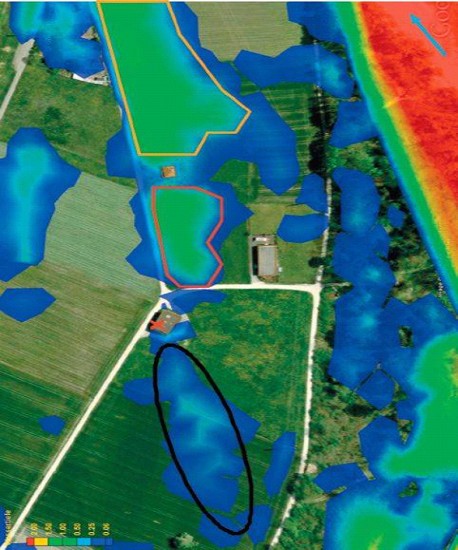The Safety of Swiss Nuclear Plants in case of External Flooding
External floods are events against which Swiss nuclear plants have to protect themselves. In order to ensure such protection, the nuclear power plant operators are obliged to review the hazard at regular intervals on the basis of experience and the latest developments in science and technology. As appropriate, they must initiate measures to continue improving safety.
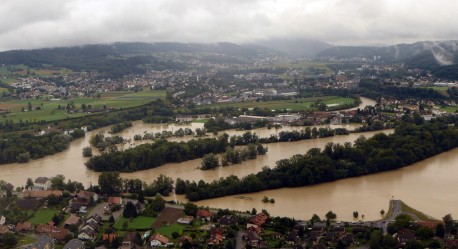
External flooding and its impact have always been elements of safety analyses in Switzerland. Over the course of time, there have been several reviews of the underlying assumptions related to flooding, for example during the periodic safety reviews (PSR). The latest reviews were carried out in connection with the general licence applications for new nuclear power plants, and on the basis of the rulings resulting from the accident at Fukushima.
It follows from Ordinance SR 732.112.2 (DETEC Ordinance on Hazard Assumptions and the Evaluation of Protection against Incidents in Nuclear Plants [Verordnung des UVEK über die Gefährdungsannahmen und die Bewertung des Schutzes gegen Störfälle in Kernanlagen]) that these events must be considered:
- The 10,000-year flood (technically: that discharge of floodwater occurring at the site due to natural reasons with a frequency greater than or equal to 10^-4 per year), and
- Any breach of a dam or weir due to a 10,000-year earthquake or flood
Breaches of dams and weirs due to earthquakes are considered in the safety analyses of seismic impacts.
Determination of discharge
In Switzerland, external floods may be caused by natural flooding events (rain, melting snow, etc.) or by the failure of hydraulic engineering installations (dams and weirs). They are characterised by the masses of water that are discharged at a specified location per unit of time – a value known as the “discharge”.
Natural flooding
The objective is to determine the discharge involved in the 10,000-year flood or in a scenario which covers the 10,000-year flood. For this purpose, the following approaches (or combinations of approaches) are acceptable:
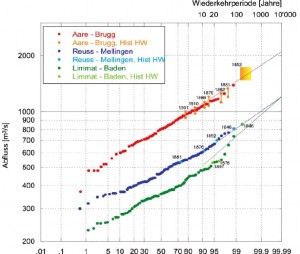 Data evaluation: data evaluation primarily takes account of the levels that have been systematically measured in Switzerland for about the last 100 to 200 years. In addition, chronicles of known flooding disasters are also considered; these can be traced back approximately to the 13th century. A data evaluation of this sort is shown in the frequency chart opposite: the annual high water levels are entered (according to their annuality, dark dots) for the river Aare at Brugg (red), the Reuss at Mellingen (blue) and the Limmat at Baden (green). The lighter dots represent estimates of the historic high water levels. This frequency analysis is used to determine how often specific high water levels occur over a certain period. The drawn-in lines indicate extrapolation to discharges with high annuality. (Source: General Licence Application, EKKB [Ersatz Kernkraftwerk Beznau AG])
Data evaluation: data evaluation primarily takes account of the levels that have been systematically measured in Switzerland for about the last 100 to 200 years. In addition, chronicles of known flooding disasters are also considered; these can be traced back approximately to the 13th century. A data evaluation of this sort is shown in the frequency chart opposite: the annual high water levels are entered (according to their annuality, dark dots) for the river Aare at Brugg (red), the Reuss at Mellingen (blue) and the Limmat at Baden (green). The lighter dots represent estimates of the historic high water levels. This frequency analysis is used to determine how often specific high water levels occur over a certain period. The drawn-in lines indicate extrapolation to discharges with high annuality. (Source: General Licence Application, EKKB [Ersatz Kernkraftwerk Beznau AG])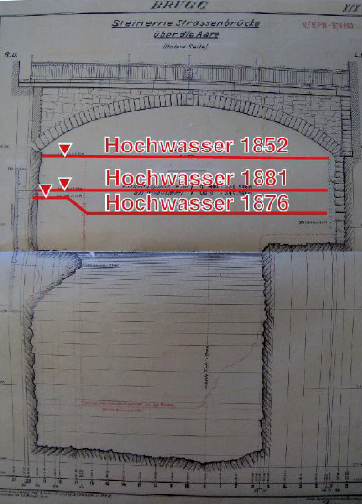 In the case of historic high water levels, it should be noted in particular that it is not always easily possible to drain off the associated discharges on account of erosion and aggradation processes in the river bed, and also because of any debris blockages that might be present due to former levels. Man-made factors such as built structures, flood protection measures and river course realignments also make it more difficult to apply the data to the situation at the time in question. Near the “Stone Road Bridge” over the Aare in Brugg, favourable conditions prevail for the drainage of discharges because the rocky riverbed means that the problems described above do not exert any relevant influence. Here too, however, it is necessary to consider whether debris blockages played a part. The figure opposite shows the three high water marks of 1852, 1876 and 1881 at this bridge. (Source: General Licence Application, EKKB, referenced there to the Federal Office for the Environment (FOEN)).
In the case of historic high water levels, it should be noted in particular that it is not always easily possible to drain off the associated discharges on account of erosion and aggradation processes in the river bed, and also because of any debris blockages that might be present due to former levels. Man-made factors such as built structures, flood protection measures and river course realignments also make it more difficult to apply the data to the situation at the time in question. Near the “Stone Road Bridge” over the Aare in Brugg, favourable conditions prevail for the drainage of discharges because the rocky riverbed means that the problems described above do not exert any relevant influence. Here too, however, it is necessary to consider whether debris blockages played a part. The figure opposite shows the three high water marks of 1852, 1876 and 1881 at this bridge. (Source: General Licence Application, EKKB, referenced there to the Federal Office for the Environment (FOEN)).A hazard curve is determined by means of extrapolation on the basis of the measurement data and the available quantitative evaluations of historic floods. The intensity (discharge) of the 10,000-year flood can be read from this curve.
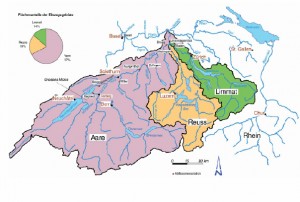 Catchment areas of rivers in Switzerland – precipitation scenarios: for sites on rivers with large catchments, precipitation scenarios are generated with various regional foci. These scenarios are not based on specific volumes of precipitation; instead, they are based on considerations as to which catchments could be affected to a greater or lesser extent by a precipitation event covering a large area. For the most important tributaries, for instance, separate flood discharges with different annualities are determined and are superimposed at the confluence, so that conclusions can be drawn about floods with high annuality. The figure opposite shows the catchment of the Aare, as relevant for the Beznau site. The main tributaries, the Reuss and the Limmat, are highlighted in colour. In this case, for example, it is possible to generate a “West” scenario (Aare: 10,000-year flood, Reuss: 10,000-year flood, Limmat: 1,000-year flood) and an “East” scenario (Aare: 1,000-year flood, Reuss: 10,000-year flood, Limmat: 10,000-year flood). (Source: General Licence Application, EKKB)
Catchment areas of rivers in Switzerland – precipitation scenarios: for sites on rivers with large catchments, precipitation scenarios are generated with various regional foci. These scenarios are not based on specific volumes of precipitation; instead, they are based on considerations as to which catchments could be affected to a greater or lesser extent by a precipitation event covering a large area. For the most important tributaries, for instance, separate flood discharges with different annualities are determined and are superimposed at the confluence, so that conclusions can be drawn about floods with high annuality. The figure opposite shows the catchment of the Aare, as relevant for the Beznau site. The main tributaries, the Reuss and the Limmat, are highlighted in colour. In this case, for example, it is possible to generate a “West” scenario (Aare: 10,000-year flood, Reuss: 10,000-year flood, Limmat: 1,000-year flood) and an “East” scenario (Aare: 1,000-year flood, Reuss: 10,000-year flood, Limmat: 10,000-year flood). (Source: General Licence Application, EKKB)
Hydrological modelling: another option is hydrological modelling of a catchment, using a block rainfall that is assumed to “cover” the hazard. In this case, “cover” means that the block rainfall should correspond to a precipitation event with a recurrence period well in excess of 10,000 years. The period of the block rainfall should be selected according to the characteristics of the catchment. However, no annuality can be assigned to a flood scenario that is determined in this way. It can merely be stated that the frequency of occurrence is less than 10^-4 per year.
Failure of hydraulic engineering installations
The Swiss Federal Office of Energy (SFOE) is responsible for the safety of dam installations. In accordance with the guideline on “Safety of Dams,” it must be proven that in case of what is known as a “safe” (probable maximum) flood, a total or partial breach of a dam or weir is excluded. If the discharge in what is regarded as a 10,000-year flood for a nuclear power plant is less than the discharge in the “safe flood” of a dam installation, it should be assumed that no breach of the dam installation will occur due to flooding. Additional consideration is given to random failures of hydraulic engineering installations (dam/weir breaches) that are independent of earthquakes and flooding.
In order to determine the effects that a failure may have, consideration is given primarily to the dams and weirs located in the catchment area of the nuclear power plant site. It may also be necessary to take account of dams and weirs located downstream, or those located on downstream tributaries. The sudden (“instantaneous”) and complete loss of damming is assumed as a “covering” scenario in order to prove the ability to cope with the incident. This scenario “covers” the hazard because, in reality, the water masses are not bound to be released completely and instantaneously, depending on the type of barrage (dam wall, dyke) and the design of the construction.
Determination of water levels
Finally, flood models are used to calculate the resultant flood heights, flow speeds and shear stresses at the site. Aerial photographs of previous floods (for example) may be compared with the relevant simulation results in order to check the models.

The following aspects may exert a major influence on the results:
- In the case of hydroelectric power plants, in accordance with document /1/, it must be assumed that the turbines are not ready to operate. More water must therefore flow away through the relief structures (weir fields, etc.), and this may result in fairly large volumes of banked-up water.
- Floating debris and bedload may lead to debris blockages in case of obstacles in the cross-section of the water flow (the cross-section of water flow is reduced due to debris that has floated towards it). This causes the river water to bank up. A break-up of the debris blockage may trigger a tidal wave which is superimposed on the flood. Debris blockages of weirs are mapped in the model by assuming that the relief structure with the greatest capacity is not available, in accordance with the regulations on dam safety. Depending on local circumstances, additional relief structures (e.g. the bottom drainage outlet) may be assumed to be blocked by debris. A total debris blockage should be considered as a sensitivity study in connection with the EU stress test.
- The resultant flood height can be influenced by aggradation or erosion processes affecting the river beds. These processes therefore require special investigation.
- In case of heavy rainfall and flooding, there is a risk of landslides. These may lead to tidal waves or impoundments with repercussions on the nuclear power plant site. Areas at risk must be identified, and the flood analysis must take account of any possible effects.
Possible effects on plants
The following effects on the plants require particular examination:
- Water may penetrate built structures (this may also happen due to an increase in the groundwater level) with resultant flooding of important equipment for safety purposes
- Water intakes may dry up (e.g. due to a breach of the downstream weir/dam) or intakes may be blocked
- Loss of stability of built structures (uplift, erosion)
- Access restrictions
- Failure of external power supply
- Back-pressure and impact of floating debris.
Measures implemented by ENSI
In connection with the general licence applications for nuclear power plants (which have since been suspended), the applicants carried out new flood analyses. The results indicate that the flooding hazard at the existing Beznau and Gösgen nuclear power plants may be greater than was originally assumed. ENSI therefore asked the operators of these nuclear power plants for a further review of the flooding hazard at the two plants. During these investigations, the safety of the plants against flooding was confirmed; however, improvements had already been implemented.
In April 2011, ENSI requested all Swiss nuclear power plant operators to undertake a new analysis of the flood hazard following the accident at Fukushima. In particular, the operators had to prove that they could cope with an extreme flood, such as may occur on average once every 10,000 years. On the basis of the relevant studies, they then demonstrated that all the Swiss nuclear power plants can be brought into a safe condition and that the applicable radiological limits are definitely respected by all the plants – even if the external power supply fails simultaneously.
By 31 March 2012, all the nuclear power plant operators must prove that:
- In case of a 10,000-year earthquake, an uncontrolled discharge of water from the dam installations which potentially endanger the nuclear power plants can be deterministically excluded; or that
- The combination of earthquake and uncontrolled water discharge from the dam installations in the area of influence that includes the nuclear power plants can be deterministically controlled. In the latter case, it must be presumed that the dam installations fail instantaneously and completely, that the cooling water intakes impacted by the tidal wave fail, and that no external power supply is available (document /2/).
References:
/1/ Basic Document on Proof of Safety against Flooding, June 2008, Swiss Federal Office of Energy (SFOE)


